Once upon a time, the federal government prohibited the disclosure of alcohol content on malt beverage labels. The rationale was to protect public health by discouraging brewers from competing in “strength wars,” to sell more product. It took years of persistence by Coors Brewing Company and a ruling from the Supreme Court in 1995 to persuade TTB (then ATF) to allow the practice. Did the strength wars ever materialize, once the rules changed? Among the major brewers, not really. In fact, we noted that there is war of a different kind — increasingly lighter beers (in alcohol and caloric content) from Anheuser-Busch and MillerCoors. But the craft beer movement appears to have its own strength war. “Extreme beers” — beers with intense flavors and alcohol contents at three, four or even five times the amounts in a typical American lager — help small brewers stand out in an increasingly crowded marketplace. And yes, they have many more calories too. Boston Beer Company offers one of the strongest beers available for sale in the United States, with their Utopias, at 24% alc./vol. and a whopping 732 calories per 12 ounce serving (as per Skilnik). Dogfish Head Craft Brewery’s 2002 release of World Wide Stout is listed at 23.04% alc./vol. and has approximately 666 calories per 12...
Continue Reading Leave a Commentbusiness strategy
Forty Proof Beer
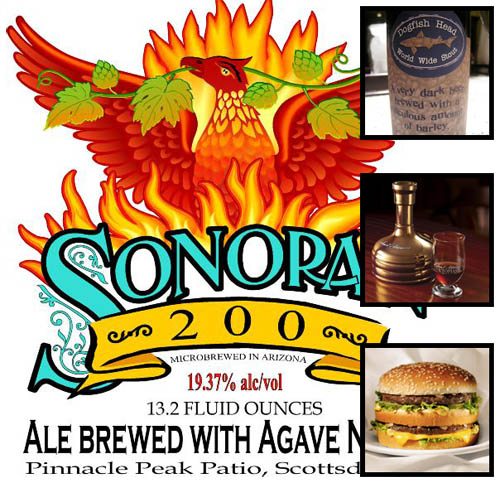
Tags: business strategy, legally interesting/controversial, policy, processing
Is Beer the New Wine?
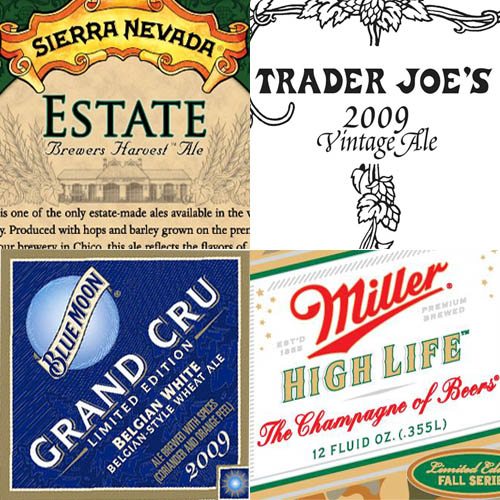
At a 2009 National Alcohol Beverage Control Association (NABCA) panel discussion, Boston Beer Company’s Jim Koch boldly proclaimed that “beer is the new wine.” According to Wine and Spirits Daily, Koch said:
With the emergence of the new mentality about beer driven by small craft brewers, America is starting to create a beer culture in the same way America has created a wine culture.
Is Koch right? The labels tell part of the story. Lately there are many examples of beer labels with terms and elements formerly associated only with wine. First is Sierra Nevada’s Estate Brewer’s Harvest Ale. TTB sets forth strict rules for wine labeled with the word “estate.” One such rule is that the wine must be produced from grapes grown on land owned or controlled by the bottling winery. According to Greg Kitsock of the Washington Post, Sierra Nevada produces their Estate Ale with hops and barley grown only at their brewery in Chico. The label adds that “this ale reflects the flavors of our surroundings in California’s fertile Central Valley.” Second is Trader Joe’s 2009 Vintage Ale, produced by Unibroue of Canada. For wine labels, it is clear that a vintage date means one thing: the year in which the grapes were harvested. What exactly does it mean...
Continue Reading Leave a CommentTags: business strategy, hybrid, policy
Miller and Bud Race Yet Again
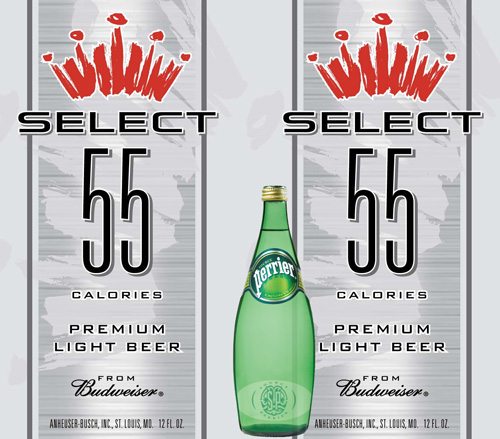
First there was Miller Lite, at about 96 calories per 12 ounces (back around 1975). In later years the non-alcoholic malt beverages (or “near beers”) became more common, with leading brands such as Clausthaler and Kaliber at about 80 calories (as per Skilnik). Now, in the past year, it appears we have a race to the bottom. That is, Miller Genuine Draft 64 came out about a year ago. It is, not surprisingly, 64 calories per 12 ounces (and 2.8% alc./vol.). Lower and more recent still is Bud Select 55. It is only 55 calories and 2.4% alc./vol. This is one important trend over the past 34 years. In a future post we will look at a countervailing trend toward very high calorie/alcohol malt beverages. All of this leads us to wonder, where will this go in the next 34 years? When the Jonas Brothers hit middle age, will they be drinking Bud Exträ Epic Mega Select 11 (down near the lower limits for the legal definition of beer)? Hops flavored Perrier?
Continue Reading Leave a CommentTags: brand extensions, business strategy, serving facts/allergens, would you drink it?
The Sports Illustrated Index: Advertising

We got to thinking that the much-ballyhooed swimsuit issue, published in Sports Illustrated every winter, might shed some light on trends in the economy, alcohol beverage advertising, and print advertising more generally. In the past, the swimsuit issue has been a prime place for beer and spirits advertising. This year’s issue is 178 pages, chock full of bikinis. Only 7.3 pages are devoted to alcohol beverage ads. This is nearly a 50% drop off from two years ago, when the economy (and print advertising) were flying a lot higher. A big part of this is due to one brand. Budweiser advertising was at seven pages in 2007 and down to a skimpy two pages in 2009. Almost all of the 2009 ads seem to be customized for the swimsuit edition. Back in 2007, it was about half and half. There is essentially no wine advertising in any of these three issues, and beer accounts for 2/3 while spirits are at about 1/3. Herewith, two of the better alcbev-centric ads tailored to this magazine.
The text on this Glenlivet Scotch ad may be hard to read, and is worth repeating. It says:
Continue Reading Leave a CommentTHE GLENLIVET was ESTABLISHED when SWIMWEAR was a lady’s SAFEGUARD from the elements. Back in 1824, even the SLIGHTEST display of ANKLE could put the FIRE in...
Tags: ad, business strategy
Red Bull Vodka and Beer
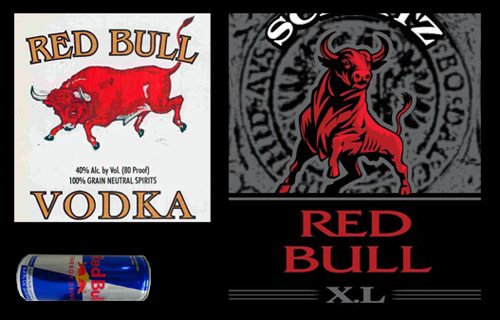
It’s a wonder that Red Bull (of Austria) has not yet come out with with an alcohol beverage. It would be likely to be a smash, in that the product is so very popular as a mixer. Perhaps things are going so well with the energy drink that there is no need to mess with it. But more likely, these two products beat the Austrians to the punch. Miller Brewing Company has approvals for Red Bull Malt Liquor going back at least as far as the early 1980s. Likewise, Majestic Distilling has approvals for Red Bull Vodka going back to 1990 or so. This Dog Style Vodka is one of the few TTB products to make explicit reference to the famous energy drink.
Continue Reading Leave a CommentTags: business strategy, caffeine/secondary effects, famous, trademarks-beverage
Highly Flammable Spirits
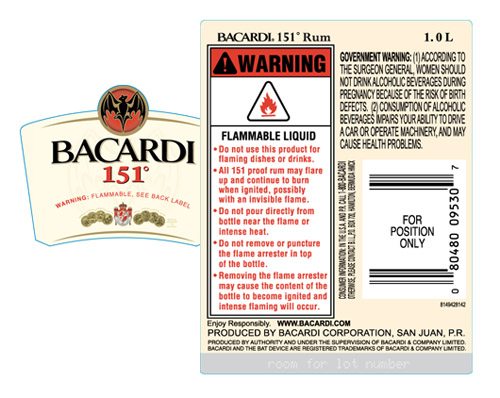
Bacardi revamped its 151 proof rum labels in May. At almost 76% alcohol, this rum is of course flammable as well as potent. The labeling includes not less than eight warnings to this effect. The bottle also includes a flame arrester. One of the main warnings says, “Do not use this product for flaming dishes or drinks.” It’s a little bit like a Maserati with a warning that you should not exceed 55 mph. We kind of thought flaming drinks were one of the main purposes for this product. If not, we went in search of the more conservative uses for this product. We found very little, with no trace of this product on Bacardi’s US website. This group seems to have no idea what to do with it either. At an even higher concentration of alcohol is Golden Grain Grain Alcohol. It is 95% alcohol and is also plastered with warnings throughout the front, back and neck labels. This is a rare example of TTB allowing warnings other than the specific health warning mandated by Congress (see this for an example of a warning not allowed). It’s hard to say the extra warnings are not warranted here.
Continue Reading Leave a CommentTags: business strategy, legally interesting/controversial, policy

